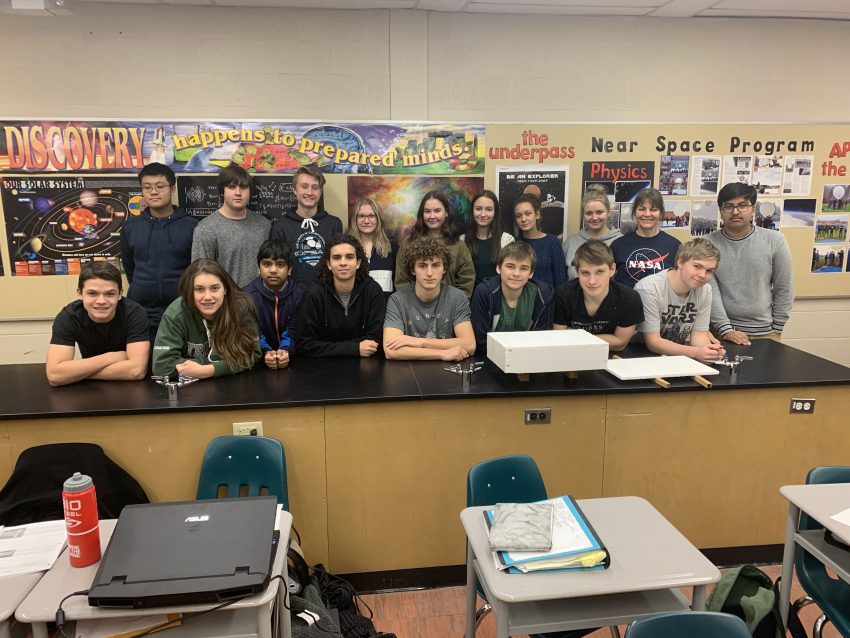Kelly Shulman’s Grade11/12 Physics class will do something very different in May with the launch of another weather balloon.
The launches have become an annual event at West Ferris Intermediate and Secondary School with the students preparing the balloon during the first semester culminating with a launch in May on the West Ferris football field.
Shulman says in addition to some repeat experiments, this year’s launch includes the weather balloon doing an underpass of a NASA satellite.
Shulman says the release of the balloon will be timed to coincide with a NASA satellite as it passes overhead although both objects will still be hundreds of kilometres apart.
The satellite’s equipment will analyze a section of air space that the payload on the balloon will also record and Shulman says comparing the data from both the balloon’s payload and satellite will take place after the flight.
Shulman says the goal is to measure the same atmospheric area within a couple of hours of the satellite passing by and the weather balloon arriving because the conditions should be relatively unchanged over that period of time.
“So we’re measuring the same air space but the measuring devices are hundreds of kilometres apart,” Shulman said.
The balloon will rise about 30 kilometres before the payload starts to record the air space around it.
The students each have different responsibilities as they prepare the payload for the May intersection.
Grade 11 student Aarya Patel is working on one of the senor groups on the payload that will measure carbon dioxide and other gases in the stratosphere.
And he says the work is tricky because the students have to achieve the right balance with the equipment.
“We need to find a senor that won’t overheat and isn’t too big where it gets in the way of the other sensors,” Patel said.
“Our sensors need to be close to the outer wall but not outside the payload and we need an airflow that goes through the box but not through the sensor.”
Patel believes he’s found a solution where some of the airflow is blocked but not to the point that it stops the sensor from collecting air samples and it continues to maintain its accuracy.
Shulman says this is one of the big takeaways from the weather balloon experiment.
“They learn to problem-solve,” she said.
“We go from problem to solution, to the next problem to the next solution. I hope they learn how to fail successfully on how to make a continual series of errors that they correct. That’s called learning.”
Shulman’s words ring true with Patel.
Not only does he have to make sure the sensor doesn’t overheat by providing the right amount of airflow, but he also has to keep it away from direct sunlight.
But the sensor also needs access to sunlight so the sun’s rays can hit a mini solar panel on the payload to power the onboard electronics.
It’s a challenge but Patel says it’s also exciting.
“It’s the first time for me to try something truly special because I have never done anything similar to this,” he said.
“I really want to be an engineer but don’t know what type so getting exposed to another area of engineering and physics can help me better prepare for a career in life.”
This year’s joint experiment with NASA is occurring because of Shulman’s visit to NASA at the Goddard Space Flight Centre in October.
She made a presentation to NASA staff about what her students had done in the past with the weather balloon and that intrigued environmental scientist Doctor Ben Poulter.
“He suggested we plan our next mission for when one of their satellite tracks passes over our heads,” Shulman said.
“So we have to be within two to three hours of the satellite track in an area that will cover about 50 square kilometres.”
Shulman says in the second semester the physics class will hand over the payload to a computer science programming class and these students will do the programming, system configurations and systems testing for the payload.
Both classes will be on hand for the launch next spring.
But exactly where the launch will take place is uncertain for now.
Schulman has noticed that with the two previous launches, the balloon has tended to drift eastward and in one of those instances the payload landed in Algonquin Park making it difficult to first locate and then retrieve it.
This has Schulman wondering if it makes more sense to carry out the next launch in Sturgeon Falls.
If past patterns repeat themselves, the balloon will drift east but this time that puts it closer to North Bay.
The payload is equipped with a tracking beacon that emits a sound the students use to pinpoint the location.
Last year’s payload was difficult to find in Algonquin Park despite the beacon because of the forested terrain.
It’s hoped getting the payload to land closer to North Bay should make it easier to locate and recover.


